It's mostly about technique; luck is temporary. In any situation, technique is the most important. Talking about luck is when you meet a big shot; otherwise, the most important thing is still technique! The crypto world is full of opportunities but also hides risks. Only by continuously learning and staying rational can one sail through the turbulent crypto sea.
My experience sharing:
Learning is fundamental: Understanding blockchain technology, the principles of digital currencies, and market trends is the premise of investment.
Rational investment: Do not blindly follow the crowd; invest according to your own risk tolerance.
Diversify investments: Do not bet all your funds on one project; diversification can reduce risk.
Long-term holding: The cryptocurrency market is highly volatile; holding quality assets for the long term is more likely to yield substantial returns.
Stay calm: Do not be swayed by market emotions; maintaining a calm mind is crucial for making correct decisions.
The stories of getting rich in the crypto world are indeed enviable, but the risks and efforts behind them cannot be ignored.
Most people face liquidation not because the coins are bad but because:
Leverage is too large.
Position size is too heavy.
Hands too quick.
Too anxious
I now constrain myself through 'daily check-ins + behavior logs + discipline cards' to truly break out of the cycle of repeated liquidation.

We have no insider information, no capital advantage, nor the trading experience to withstand several rounds of bull and bear markets. What we can rely on is only recognizing the market, recognizing ourselves, establishing rules, and controlling emotions.
The crypto world is not a shortcut to wealth but a battleground where only a few survive.
One, first recognize the market: This is a world where uncertainty reigns.
The essence of the market is not a technical battle but a highly complex probability game.
You must accept that no matter how sophisticated a strategy is, it cannot consistently profit in all environments. Any trading system claiming '100% win rate' is a scam.
What we can do is not to defeat the market but to adapt to the market, using discipline to combat uncertainty.
Profits and losses come from the same source: The way you make money determines the depth of your losses. Heavy betting: It can double your capital but can also lead to zero. High leverage for rebounds: You might get a bite, but if you go in the wrong direction, you get liquidated. Averaging down against the trend: Sometimes it can save you, but in a one-sided trend, it's slow suicide.
The traders who truly survive are those who repeatedly bet on 'probability advantages' in a systematic way—earning more when right, losing less when wrong. Two, recognize yourself again: You are not a genius, nor are you a 'cool evening'.
Most people do not die in the market due to ignorance, but because of self-righteousness: Obsessed with predictions: Trying to catch all tops and bottoms; technical obsession: Piling on indicators while ignoring positions and risk control; superstitious luck: Attribute wins to themselves and blame the market for losses; overconfidence: After several profitable trades, they think they are invincible.
Please remember: Discipline > Technique, Execution > Inspiration, Stability > Excitement.
The truly profitable trades are often boring.
Three, the underlying logic that ordinary people can also profit.
You don't need to be a genius; you just need to establish a replicable and consistent trading system.
1) Capital management: Use only a small portion of total funds for each trade, light positions for trial and error; confirm trends before adding positions; do not start with heavy positions; total position should not exceed 30%, leaving room for maneuver.
2) Suitable timeframes: Short-term: Those with strong market sense and quick reactions play waves; suitable for those who can withstand fluctuations and ride trends; long-term: Those who understand macroeconomics and fundamentals have better odds.
3) Trading systems must be simple, executable, and replicable: Trend strategy: follow the trend, don't add positions against it; fluctuation strategy: buy low and sell high, stop losses should be quick; arbitrage strategy: cross-platform price differences, small fluctuations for high win rates but slow.
4) Stop loss and take profit must be mechanically executed; set stop loss before entering, cut losses at the point, take profits in batches, without greed or fear; capturing mid-term trends is enough.
5) Emotional management: Reduce the frequency of watching the market, avoid impulsive trading, accept losses, avoid averaging down on losses, don't expand positions after winning, keep a trading journal, and continuously review and optimize the system. Four, the key to truly surviving: mindset and compound interest.
The hardest thing to defeat in the crypto world is not the market but one's own greed and fear.
What you need to do is not 'ten times in a year' but rather stable annual returns + strict stop losses + not being wiped out by the market.
Don't underestimate the importance of 'surviving'; compound interest is the only way retail investors can compete with institutions: 30% annualized, 10 years is 20 times; 50% annualized, 10 years is 57 times; doubling in one year, getting liquidated in the second year is zero.
And if you accidentally incur a loss—
Final advice: Don't become a 'legend', instead, be a 'survivor'.
In the crypto world, legendary stories belong to a very small number of people; the vast majority of winners are ordinary people who can survive in a long market.
Make fewer mistakes, execute more, regularly review, and maintain rationality and patience.
In trading, have you ever felt confused: A trend in a certain timeframe shows bullish, while a trend in another timeframe shows bearish?
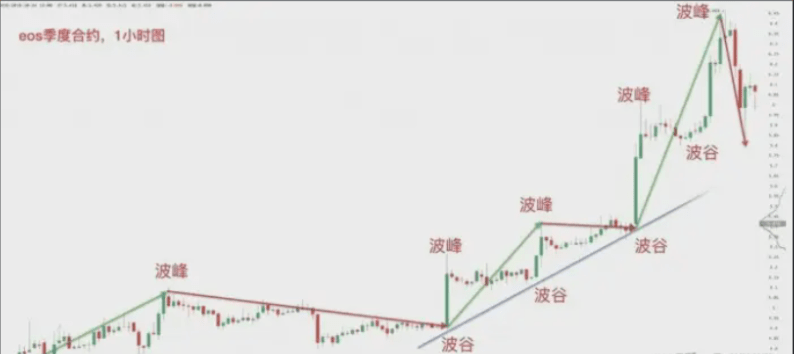
For example: On the 1-hour chart of EOS quarterly contracts, the price peaks and troughs gradually rise, forming a clear uptrend. However, when switching to the daily chart, the peaks and troughs gradually lower, forming a downtrend.
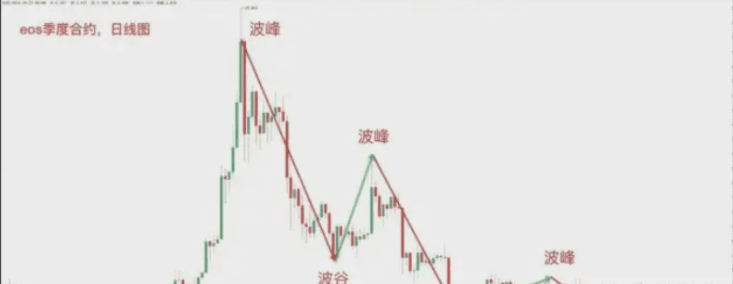
Essence of the problem: Multi-timeframe trend conflict
Short period: Trends are sensitive, capturing short-term fluctuations, but signals are more easily affected by noise.
Long period: Trends are more stable, excluding short-term fluctuations, but react slowly.
Core question: How should we determine the trading direction? Bullish or bearish?
Carefully observe that the patterns resembling waves indicate that the long-term trend is actually composed of multiple medium-term trends, which in turn consist of several short-term trends.
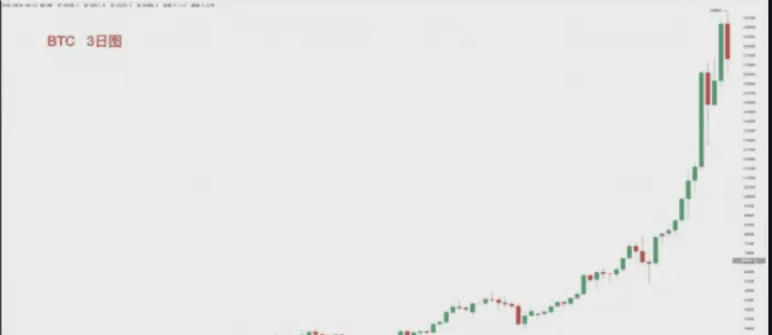
Generally, the bull or bear markets that investors love to discuss refer to long-term trends spanning several months or years.
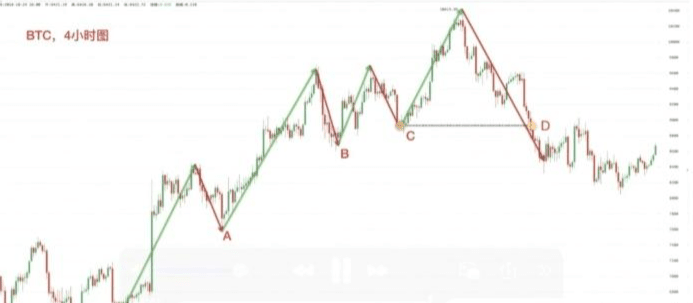
Two, classification of trend timeframes
1. Three types of trends
Short-term trends: Fluctuations within hours, the main reference period for short-term trading.
Medium-term trend: Fluctuations from a few hours to a few days, the main reference period for medium-term trading.
Long-term trends: Spanning days to weeks or longer, the main reference period for long-term trading.
The chart below is the 4-hour candlestick chart of BTC/USDT, where the valleys A, B, and C gradually rise, forming an uptrend. When the price drops back to point D, below the recent rise starting point C, it confirms the end of the uptrend.
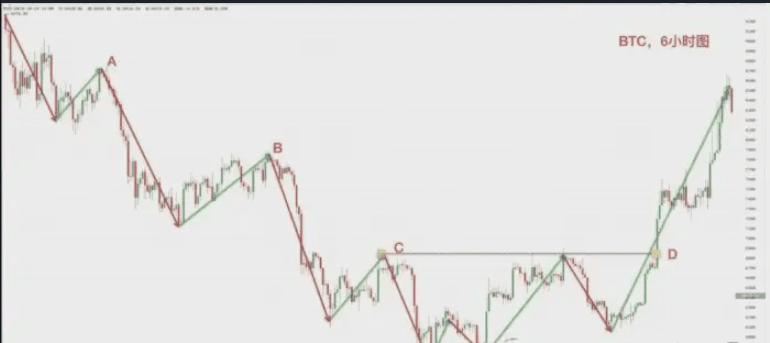
Practical example: BTC multi-timeframe trend analysis
Short-term trend (1-hour chart): Local rebounds or pullbacks, the core of short-term trading.
Medium-term trend (4-hour chart): Periodic rises or falls, reflecting mid-term capital sentiment.
Long-term trend (daily or weekly): Sustained bull or bear markets, the main basis for large capital inflows and outflows.
2. The multi-timeframe structure of trends.
Short-term trends overlap: Constitute medium-term trends.
Medium-term trends overlap: Constitute long-term trends.
Practical advice: Confirm trend direction through multi-timeframe switching to avoid being misled by a single timeframe.
Three, distinguishing between major and minor trends: Interpretation of Dow Theory.
1. Three types of trend structures
Major trend: The primary direction of the market, lasting the longest, such as a bull or bear market.
Secondary trend: Corrective fluctuations within the major trend, such as short-term pullbacks in a bull market or rebounds in a bear market.
Short-term trends: Subtle fluctuations within the major or secondary trends, the focus of short-term traders.
2. Practical case: BTC trend layering
Major trend (weekly): The super bull market of BTC from 2015 to 2017, where the price rose from $200 to $20,000.
Secondary trend (daily): Every pullback in a bull market is an opportunity for bulls to enter.
Brief trend (4-hour): Intraday fluctuations, the core of short-term traders' operations.
3. The fluctuation amplitude of trends: Application of Dow Theory.
Secondary trend pullback amplitude: Generally 1/3 to 2/3 of the major trend.
How to utilize: The pullback amplitude can serve as a basis for stop losses and position increases.
Four, the lifecycle of trends: Birth, development, and decline.
1. The three major stages of trends
The birth of a trend: Breaking through key support or resistance levels, the trend begins to emerge.
The development of trends: Trends continue to operate, rebounding or pulling back multiple times, but always maintaining the main direction.
The decline of a trend: When the trend reverses, and the previous high or low is broken, it confirms the end of the trend.
2. Judging trend reversals
End of an uptrend: A new low below the starting point of the previous wave's rise.
End of a downtrend: A new high above the starting point of the previous wave's decline.
Five, coping strategies under trend conflicts: Multi-timeframe trading rules.
1. Multi-timeframe trend confirmation method
Determine trading direction: First confirm the long-term trend direction, then observe the medium-term trend to find entry opportunities, and finally execute entries through the short-term trend.
Core thought: Short-term follows medium-term, medium-term follows long-term.
2. Responding to multi-timeframe trend conflicts.
Long-term investors: Focus only on major trends, ignoring secondary and short-term trends.
Medium-term traders: Look for reversal opportunities in secondary trends within the major trend.
Short-term traders: Capture brief trend fluctuations within secondary trends.
3. Practical skills: Three-timeframe trading method.
Long-term trend (weekly): Confirming the direction of the bull or bear market.
Medium-term trend (daily): Look for pullbacks or rebounds in the main direction.
Short-term trend (4-hour): Determine entry and exit signals, execute trades.
Six, case analysis: For example, BTC multi-timeframe trend trading
1. Confirm the major trend
Period: Weekly or monthly.
Direction: Confirm bull or bear market.
2. Capture secondary trends.
Period: Daily.
Signal: Pullbacks to key support or resistance levels, using trend lines and moving averages to assist in judgment.
3. Execute short-term trades.
Period: 4 hours or 1 hour.
Strategy: Combine candlestick patterns and technical indicators (such as MACD, RSI, MA) to execute entries, stop losses, and take profits.
Seven, practical summary: Choose a trend timeframe that suits you.
Long-term investors: Focus on major trends, with periods being weekly or monthly.
Medium-term traders: Focus on secondary trends, with periods being daily or 4-hour charts.
Short-term traders: Focus on brief trends, with periods being 1 hour or shorter.
Key thought:
Trends vary in size, and periods vary in length; choose a timeframe that suits you and follow the trend.
Do not easily guess tops or bottoms before the trend is confirmed to be over.
In trend conflicts, use the larger timeframe as the main reference, and smaller timeframes as supporting.
Still the same, if you don't know how to trade in a bull market, click on A-wen's avatar, follow for bull market spot planning, contract passwords, and free sharing.


